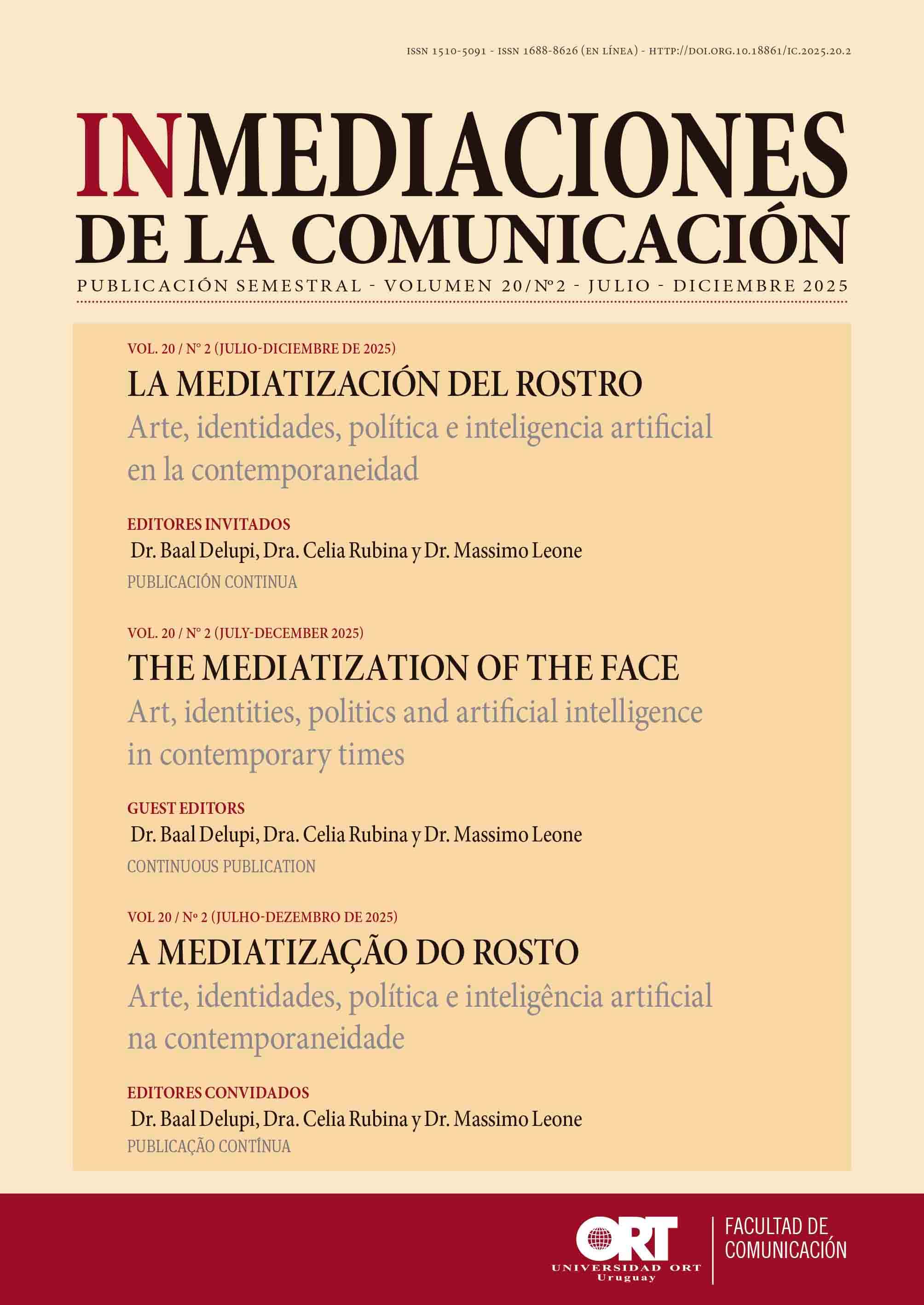Artificial intelligence and otherness
Representations of immigrants using generative image creation tools
DOI:
https://doi.org/10.18861/ic.2025.20.2.4108Keywords:
Artificial Intelligence, identity, representation, immigration, SemioticsAbstract
We cannot deny, for better or for worse, that the democratization and accessibility of artificial intelligence represent an epistemological, social and technical turning point in society. In this context, it is necessary to investigate how tools for creating generative images represent and narrate the identities of people from a migrant background. On the basis of a common list of commands (prompts), entered in different geographical areas and in different languages, the purpose of this article is to determine whether the different tools generate representations that corroborate the maintenance of certain paradigms, such as those associated with stereotypes, or whether, on the contrary, they propose a different way of seeing the world by breaking with certain “received ideas” about immigrants. For this purpose, we use three different image generation tools, DALL-E 2, Midjourney and Stable Diffusion. The article presents two main aspects: the first, the establishment of a methodological research framework in relation to artificial intelligence tools; the second, the semiotic analysis of the results. The analysis of the images generated takes into account symbolic, political and expressive aspects, drawing on theoretical approaches from identity theories, sociosemiotics and discursive semiotics.
Downloads
References
Almeida, G. M. R. de & Baeninger, R. (2016). A imigração brasileira na França: do tipo histórico às modalidades migratórias contemporâneas. Revista brasileira de estudos de população, 33(1), 129-154. https://doi.org/10.20947/S0102-309820160007
Arnold, M. (1989). La sémiotique: un instrument pour la représentation des connaissances en intelligence artificielle. Études littéraires, 21(3), 81-90. https://doi.org/10.7202/500872ar
Beyaert-Geslin, A. (2021) L’invention de l’autre : Le juif, le noir, le paysan, l’alien. Paris, Classiques Garnier.
Cambridge English Dictionary. (n.d.). Immigrant. In Cambridge English Dictionary (online). Cambridge University Press. https://dictionary.cambridge.org/dictionary/english/immigrant
Cambridge English Dictionary. (n.d.). Migrant. In Cambridge English Dictionary (online). Cambridge University Press. https://dictionary.cambridge.org/dictionary/english/migrant
Centre National de Ressources Textuelles et Lexicales. (n.d.). Immigrant. In CNRTL online lexical resource. CNRTL. https://www.cnrtl.fr/definition/immigrant
Centre National de Ressources Textuelles et Lexicales. (n.d.). Migrant. In CNRTL online lexical resource. CNRTL. https://www.cnrtl.fr/definition/migrant
Commission de l’intelligence artificielle. Ministère de l'Économie, des Finances et de la Relance (2024). IA: Notre ambition pour la France. Gouvernement. https://www.economie.gouv.fr/files/files/directions_services/cge/commission-IA.pdf
D’Armenio, E., Deliège, A. & Dondero, M. G. (2024). Semiotics of Machinic Co-Enunciation. Signata. http://journals.openedition.org/signata/5290.
Davallon, J. (1984). Sociosémiotique des images. Langage et société, 28(2), 111-140.
Deleuze, G. & Guattari, F. (1976). Rhizome. Minuit.
Dondero, M. G. (2020). Les langages de l’image. De la peinture aux Big Visual Data. Hermann.
Dondero, M. G. (2024). Inteligência artificial e enunciação: análise de grandes coleções de imagens e geração automática via Midjourney. Todas as letras. Revista de língua e literatura, 26(2), 1-24. https://editorarevistas.mackenzie.br/index.php/tl/article/view/17164
Floch, J.-M. (1981a). Kandinsky: sémiotique d'un discours plastique non figuratif. Communications, 34.
Floch, J.-M. (1981b). Sémiotique plastique et langage publicitaire. Actes Sémiotiques, Documents EHESS - CNRS, 3(26), 27pp.
Floch, J.-M. (1985). Petites mythologies de l’œil et de l’esprit. Pour une sémiotique plastique. Hadès Benjamins.
Floch, J.-M. (1986). Les formes de l’empreinte. Pierre Fanlac.
Fontanille, J. (2008). Pratiques Sémiotiques. Presses Universitaires de France.
Fontanille, J. (2011). L’analyse du cours d’action: des pratiques et des corps. Semen, 32. http://journals.openedition.org/semen/9396
Fontanille, J. (2016). Sémiotique du discours. PULIM.
Gobetti, S. (2024). Concentração de renda no topo: novas revelações pelos dados do IRPF. Observatório de Política Fiscal. https://observatorio-politica-fiscal.ibre.fgv.br/politica-economica/pesquisa-academica/concentracao-de-renda-no-topo-novas-revelacoes-pelos-dados-do
Greimas, A. J. & Courtés, J. (1979). Sémiotique: dictionnaire raisonné de la théorie du langage. Hachette.
Greimas, A. J. (1968). Conditions d'une sémiotique du monde naturel. Langages, 3(10), 3-35.
Greimas, A. J. (1984). Sémiotique figurative et sémiotique plastique. Actes Sémiotiques - Documents EHESS - CNRS, VI, 60, 24pp.
Houaiss, A. (n.d.). Imigrante. In Houaiss dictionary of Brazilian Portuguese (online edition). Instituto Antônio Houaiss. https://houaiss.uol.com.br/busca?palavra=imigrante
Houaiss, A. (n.d.). Migrante. In Houaiss dictionary of Brazilian Portuguese (online edition). Instituto Antônio Houaiss. https://houaiss.uol.com.br/busca?palavra=migrante
Lacroix, T. (2016). Migrants: L'impasse européenne. Armand Colin.
Landowski, E. (1997). Présences de l’autre. Essais de socio-sémiotique II. Presses Université de France.
Leone, M. (2021). Mala Cara: Normalidad y alteridad en la percepción y en la representación del rostro Humano. Signa: Revista de la Asociación Española de Semiótica, 30, 191-211. https://doi.org/10.5944/signa.vol30.2021.29305
Le Robert. (n.d.). Immigrant. In Le Robert online dictionary. Le Robert. https://dictionnaire.lerobert.com/definition/immigrant
Le Robert. (n.d.). Migrant. In Le Robert online dictionary. Le Robert. https://dictionnaire.lerobert.com/definition/migrant
Lotman, Y. (1999). La semiosphère. PULIM.
Meunier, J. G. (1989). Artificial intelligence and the theory of Sign. Semiotica, volume 77, issue 1-3, 43-63.
Pinheiro, A. (2017). A condição mestiça. Online, available at https://escritablog.blogspot.com/2019/03/a-condicao-mestica-amalio-pinheiro.html
Picanço Cruz, E., Queiroz Falcão, R. P. de, Silva, M. L, da & Neves Penna, B. das (2021). Research report: Profile of Brazilians in France. Programa Institucional de Bolsas de Iniciação Científica FUNADESP-UNIGRANRIO. https://mpeinternacional.uff.br/wp-content/uploads/sites/53/2021/03/Relatorio-Brasileiros-na-Franca_FINAL.pdf
Rialle, V. (1996). IA et sujet humain: entre physis et sémiosis. Intellectica. Revue de l'Association pour la Recherche Cognitive, 23, 121-153. https://www.persee.fr/doc/intel_0769-4113_1996_num_23_2_1533
Saussure, F. (1931). Cours de Linguistique Générale. Payot.
Strochlic, N. (2017). Famosa “menina afegã” finalmente consegue um lar. National Geographic. https://www.nationalgeographicbrasil.com/sharbat-gula/2017/12/famosa-menina-afega-finalmente-consegue-um-lar-capa-historica-refugiado-afeganistao
Thérien, G. (1989). Sémiotique et intelligence artificielle. Études littéraires, 21(3), 67-80. https://doi.org/10.7202/500871ar
Thürlemann, F. (1982). Paul Klee, analyse sémiotique de trois peintures. Age d’Homme.






